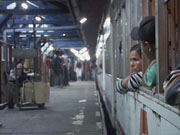
|
|
In den frühen Abendstunden erreicht der sogenannte 'weiße Zug' Buenos Aires. Er hat in den Vororten Männer, Frauen und Kinder eingesammelt, sog. 'cartoneros', 'Kartonmenschen'. Sie versuchen ihren Lebensunterhalt damit zu verdienen, dass sie einsammeln, was andere weggeworfen haben. [aus dem Forum-Programm] QUESTIONNAIRE How would you describe the aesthetics of your film? Many people who saw our movie say that it has a " cartonera aesthetics ", probably relating that " aesthetics of hunger " that Glouber Rocha used to talk about. We believe that we could take form in image what the characters and the environment wanted to communicate, as the dirt or the darkness. We believe that if this movie had been shot in 35mm the result had not been the same. Why did you choose to shoot on dv? The urgency to show what was happening made us choose DVCAM support, though the financial aspect was also very important, we only had money to rent the camera and to buy the cassettes. Then, during the first days of shooting, we perceive that the quality was very good giving us the right result to the situations that the history impose us, like for example to shoot in the dark inside the train that it was only illuminated with the lights of the street that pass through the window. What was special about shooting in dv (e.g. compared to 35mm, was it your first time with dv or are you used to it)? The first advantages that the DVCAM gave us were the cassettes we used during the interviews. With those elements we could record the image without losing the raw stack material which is very expensive. Then, regarding the sound aspect, the possibility of using the entry XLR of the SONY PD150, gave us a great quality. It was the first time that we used this kind of supports (DVCAM). What was your shoot-edit ratio? We shot in Fullscreen and, during the process to pass to 35 mm we modificated the format to 16:9. Would you have preferred to shoot in another format? If so which? We are not agree with the result obtained in the process to 35mm, we believe that apart from the facilities that we have mentioned before, this documentary could not have been shot with another camera. Does using dv mean that you are considering other means of distribution opposing the established? If so which? We do not consider another way of distribution. Though we have a clear idea that here, in Argentina, has been begun to exhibit successfully movies in digital video format. Anyway, to enlarge the film to 35mm we have begun to travel the traditional way of exhibition of any movie. One good word about dv (or two): Quality, Facility One bad word about dv (or two): Very sensible lens [zurück zur DV-FILM ÜBERSICHT] [nach oben] |
